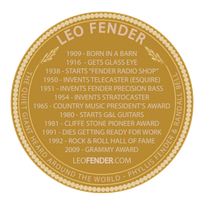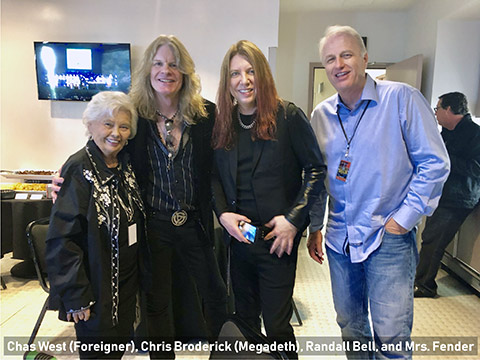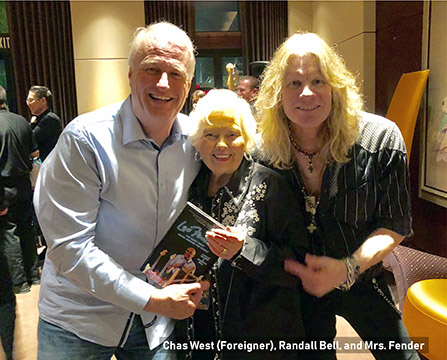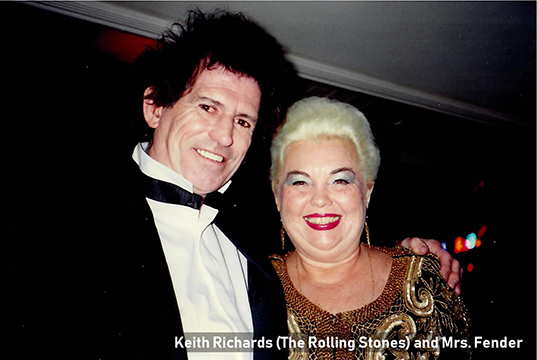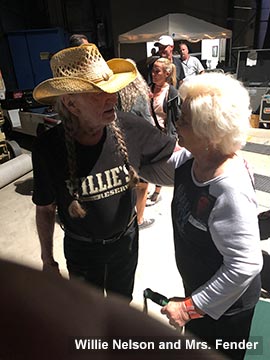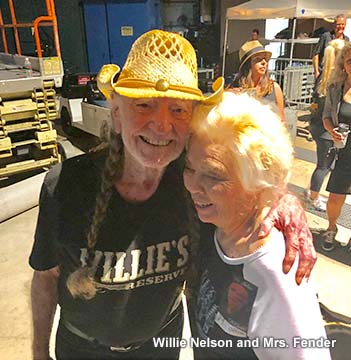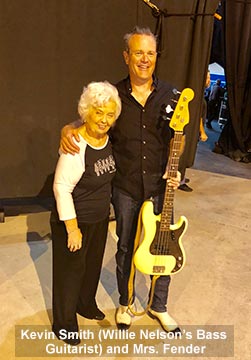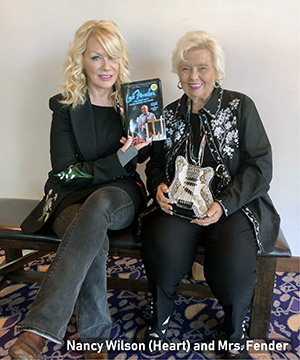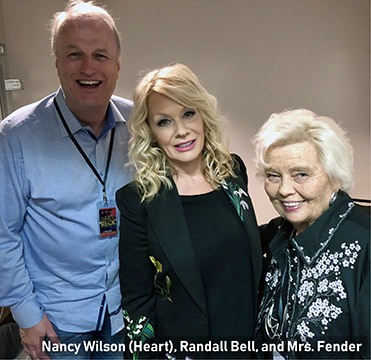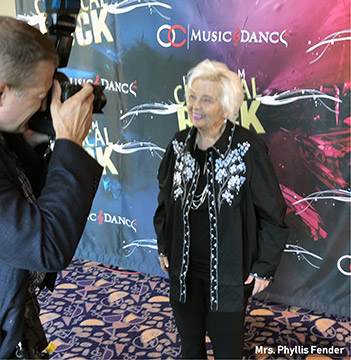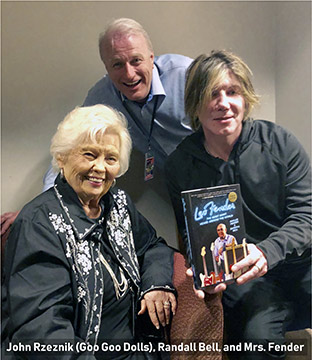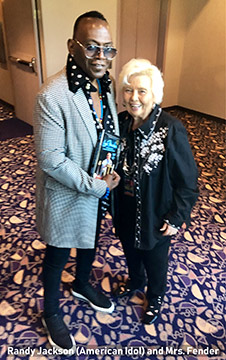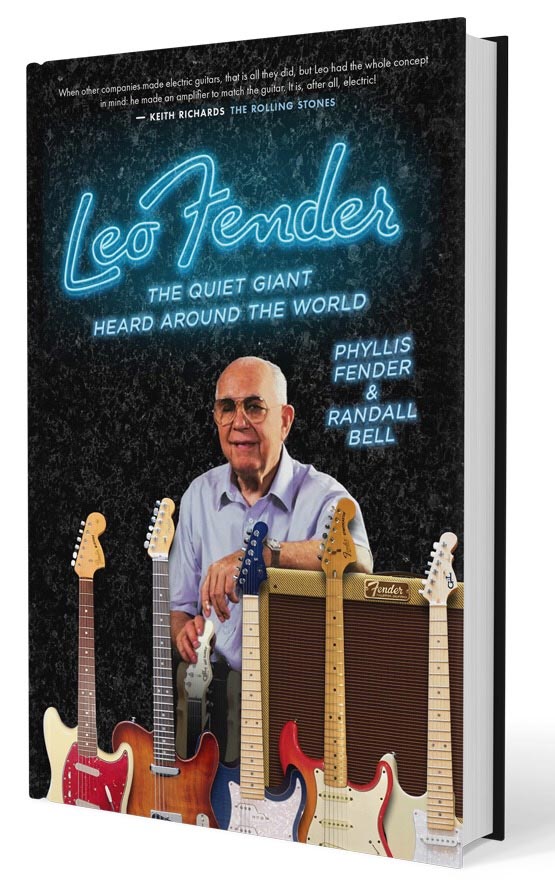
Occasionally, the world produces one of those rare thinkers that alters the course of history.
Disney reinvented entertainment, Einstein revolutionized science, Edison lit up our lives with the light bulb, Bell got the world talking with the telephone, … and Fender revolutionized music.
If you think about it, Leo Fender has influenced every person on earth today—at least everyone who has ever heard a song.
When Leo first invented the electric guitar, people laughed at him. They thought that his new guitars looked more like boat paddles. Yet, Leo’s guitars went on to be used by everyone from Elvis Presley to Eric Clapton and from Jimmy Page to Jimmy Hendrix. Rolling Stone magazine published a list of the world’s top 100 guitarists, and 90 of them used one of Leo’s guitars on stage. The other 10 used guitars that copied Leo’s inventions.
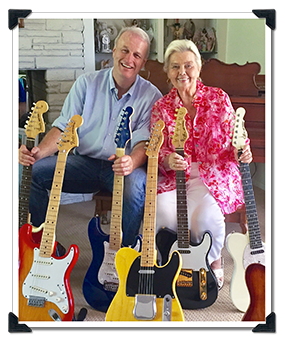 Leo Fender was shy, had one glass eye, and was nearly deaf. Yet, from the small town of Fullerton, California, he built an iconic empire that is worshiped by rock stars worldwide. The highest price ever spent for music memorabilia was not for Michael Jackson’s glove, original Beatles’ handwritten lyrics, or even one of Elvis’ killer pantsuits. It was for a Fender Stratocaster, which sold for a staggering $2.7 million.
Leo Fender was shy, had one glass eye, and was nearly deaf. Yet, from the small town of Fullerton, California, he built an iconic empire that is worshiped by rock stars worldwide. The highest price ever spent for music memorabilia was not for Michael Jackson’s glove, original Beatles’ handwritten lyrics, or even one of Elvis’ killer pantsuits. It was for a Fender Stratocaster, which sold for a staggering $2.7 million.
Literally born in a barn, Leo went on to amass wild fame and fortune and win a Grammy Award, an Academy of Country Music Award, and a Cliffie Stone Pioneer Award. He was the Grand Marshal at parades and was inducted into the Rock and Roll Hall of Fame.
Today, Fender is a household name, but you can take the image of a world-famous, wealthy business icon and throw it out the window! Written by the wife of the late Leo Fender, this book provides, for the very first time, an unprecedented look into to the wonderful world of this quiet genius.
Phyllis Fender and Randall Bell on
Fox 5 San Diego
Phyllis Fender, author of “Leo Fender: The Quiet Giant Heard Around the World,” along with co-author Dr. Randall Bell met with Fox 5 San Diego to discuss the guitar legend.
Phyllis Fender & Randall Bell on
KTLA's TV Morning Show
Phyllis Fender, author of “Leo Fender: The Quiet Giant Heard Around the World,” along with co-author Dr. Randall Bell met with KTLA Channel 5's Morning News show to discuss the guitar legend.
Phyllis Fender & Randall Bell on
WGN9's Mid-Day Fix
Phyllis Fender, author of “Leo Fender: The Quiet Giant Heard Around the World,” along with co-author Dr. Randall Bell met with WGN9's Mid-Day Fix to discuss the guitar legend.
Praise for, Leo Fender: The Quiet Giant Heard Around the World

Playing The Keys To An Electric Leadership Legacy
Read More ▼
Playing The Keys To An Electric Leadership Legacy
Kevin Cashman, Contributor
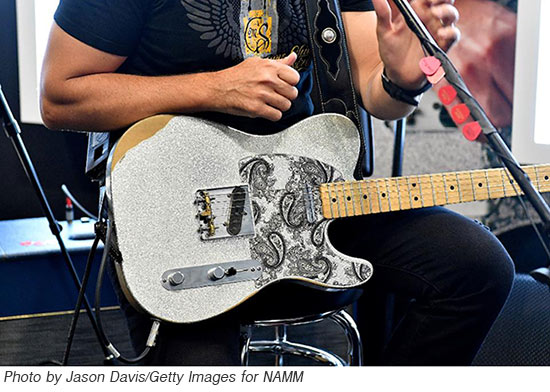 Leo Fender was a pioneer in the design and improvement of the electric guitar. As innovative as he was to music, his leadership was electric too. His resonant tones moved millions but so did the progressive tone of his leadership.
Leo Fender was a pioneer in the design and improvement of the electric guitar. As innovative as he was to music, his leadership was electric too. His resonant tones moved millions but so did the progressive tone of his leadership.
Occasionally, the world produces one of those rare leaders who alter the course of history. Disney reinvented entertainment, Einstein revolutionized science, Edison lit up our lives with the light bulb, Bell got the world talking with the telephone – and Fender electrified music. Leo Fender has influenced every person on earth today – at least everyone who has ever heard a song.
When Leo released his Telecaster guitar, people laughed at him. Noting their strange, flat design, his critics said that all his strange guitars were useful for was to paddle boats. Yet, Leo’s guitars went on to be used by everyone from Elvis Presley to Eric Clapton and from Jimmy Page to Jimmy Hendrix. Indeed, Rolling Stone Magazine published a list of the world’s top 100 guitarists, and 90 of them played a Fender on stage.
Leo Fender was shy, had one glass eye, and was nearly deaf. Yet, from the small town of Fullerton, California, he built an iconic empire that is worshiped by rock stars worldwide. The highest price ever spent for music memorabilia was not for Michael Jackson’s glove, original Beatles’ handwritten lyrics or even Elvis’ killer pantsuit. It was for a Fender Stratocaster, which sold for a staggering $2.7 million.
But Leo also set some high standards in authentic leadership. As described in their upcoming book, Leo Fender: The Quiet Giant Heard Around the World, Phyllis Fender and Randall Bell shared many ways to make your leadership even more “electric.” I have distilled a few here:
- Electric Leadership Key One: Put Meaning Before Money. While conventional wisdom might say a CEO must focus on the bottom line, Leo felt differently, knowing that purpose was the real driver of performance. Leo agreed with Mark Twain, “The two most important days of your life are the day you are born and the day you learn why.” Leo was not driven by money. He knew exactly his life’s purpose, and he was driven by a deep desire to craft the perfect musical instrument. At times, he would sell products at a loss, just so customers would have a better selection. Staying true to his purpose was the actual driver behind Leo’s financial empire.
- Electric Leadership Key Two: Be Agile Not Specialized. Leo laughed at companies that were too rigidly specialized. He was comfortable with making an executive decision, as he was dropping to the floor with a screwdriver and fixing a machine out in the plant. He designed his facilities, mastered electronics, enjoyed woodworking, organized the bookkeeping, and was as comfortable at a drafting table as he was at a board table. Remarkably, as a CEO, Leo was proficient at every job held by his 1,000-plus employees. He would regularly leave his office and walk the entire plant, from the receiving department to look over the wood deliveries, to the manufacturing line to the shipping department. He knew every square inch of the place. If a job needed to be done, he would do it. He did not lead by position or title, he led by authentic example.
- Electric Leadership Key Three: Dress to Work, Not for Success. Leo dressed to get the work done, not according to his CEO role or the expectations of others. He did not dress like a CEO or a rock star, he dressed to do his job and his wildly dressed rock clients loved that he was clearly there to do his job with focus and precision. He often looked like a factory worker and visitors often assumed he was one. Generally, he wore black shoes and socks, and black pants and belts. His only choice was to wear a blue or white short-sleeve shirt. He didn’t want to waste time coordinating an outfit. Of course, Leo always had a plastic pocket protector with a pen, ruler and tiny notebook. When he had to wear a tie, it was a clip-on, so he could unclip it as soon as he could. He dressed comfortably and functionally, not to impress.
- Electric Leadership Key Four: Be Open to Learn and Collaborate. Many leaders recruit an inner circle of “yes men” to follow their orders. Leo did the opposite. He shunned “yes men” and the notion of a “unanimous vote” was trivial. He loved critical thinking, real debate and people who told him the way it really was. One day he ran into a guy by the name of Freddie Travaris, who immediately told Leo that his amplifiers were flawed. Leo calmly asked him to tell him more, and Freddie turned around the amp and pointed out various design issues. Leo hired him on the spot. The next day, Freddie and Leo sketched out a new guitar, the Fender Stratocaster, which became the biggest selling guitar in the history of the world.
- Electric Leadership Key Five: Love Your Competition. Often the business mindset is to create barriers to the competition. Leo never felt threatened with the competition, just the opposite. He and Les Paul, the head of Gibson Guitars, were good friends and spent many afternoons sipping lemonade, and talking about the music industry and new design ideas. They helped each other. Occasionally Leo would joke around and say, “Well, there’s always room for number two!” But seriously, Leo had a high level of respect for Les, and he thought Gibson guitars were beautifully crafted.
- Electric Leadership Key Six: Set Trends vs. Study Trends. Many leaders watch the market like a hawk. On the other hand, Leo quietly felt the vibe of everything around him. Fender did not perfect the electric guitar to get rich and famous. The genesis of Fender was Leo’s desire to help some acoustic guitarists at a World War II bond dance, who were being drowned out by the loud drums and horns. Leo did not play the guitar. Remarkably, he could not even tune a guitar! He didn’t develop the guitar for himself, but rather he just wanted to help the little guy get heard. Service was the vibe that drove him. Like all great go-beyond leaders, Leo Fender did not study the market trends, he defined them.
- Electric Leadership Key Seven: To Retire is to Expire. Like many purpose-driven leaders, Leo though that leaving the thing he loved was a joke and would be boring. He loved what he did and he was always fiercely engaged and active. He had hobbies and took vacations but was always excited to return to his passion. Leo suddenly passed away in his home at the age of 81, doing what he had done for decades, getting ready to go to his beloved work.
Leo Fender did not build an iconic empire by falling into line. He believed that conventional wisdom would get you conventional results. His authentic, purpose-driven leadership not only produced fame, fortune and nearly every music award you can think of, he became a leader of life. Leo Fender broke with convention, followed his purpose and created a life worth living.
How can your leadership be even more electric, authentic and purpose-driven?

Leo Fender's widow to release book about the guitar inventor and Orange County native
Read More ▼
Leo Fender's widow to release book about the guitar inventor and Orange County native
Bradley Zint, Contact Reporter
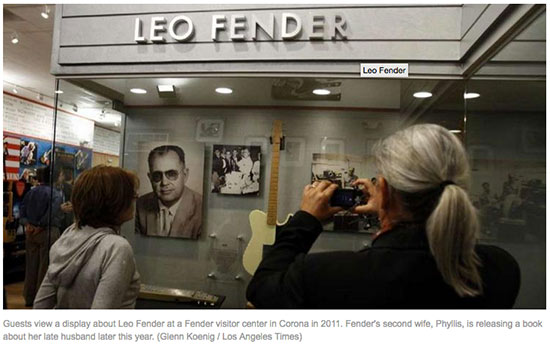 The wife of late guitar legend and Orange County native Leo Fender is releasing a new book later this year.
The wife of late guitar legend and Orange County native Leo Fender is releasing a new book later this year.
Phyllis Fender’s “Leo Fender: The Quiet Giant Heard Around the World,” which she co-wrote with Laguna Beach author Randall Bell, will be released Nov. 1 by Leadership Institute Press. It is available for pre-order on Amazon.
Phyllis Fender, his second wife, discusses how the famous inventor “never lived large or flaunted his fame,” according to a news release. “He lived in a mobile home, even after selling his company for $300 million (in today’s dollars). His daily routines and obsessions made him truly fascinating, and thanks to his enduring instruments, Fender’s legacy forever lives on.”
Fender was born in Anaheim in 1909 and raised in Fullerton, where he died in 1991 at age 81.

Leo Fender: The Quiet Giant Heard Around the World
Read More ▼
Leo Fender: The Quiet Giant Heard Around the World
Steve B.
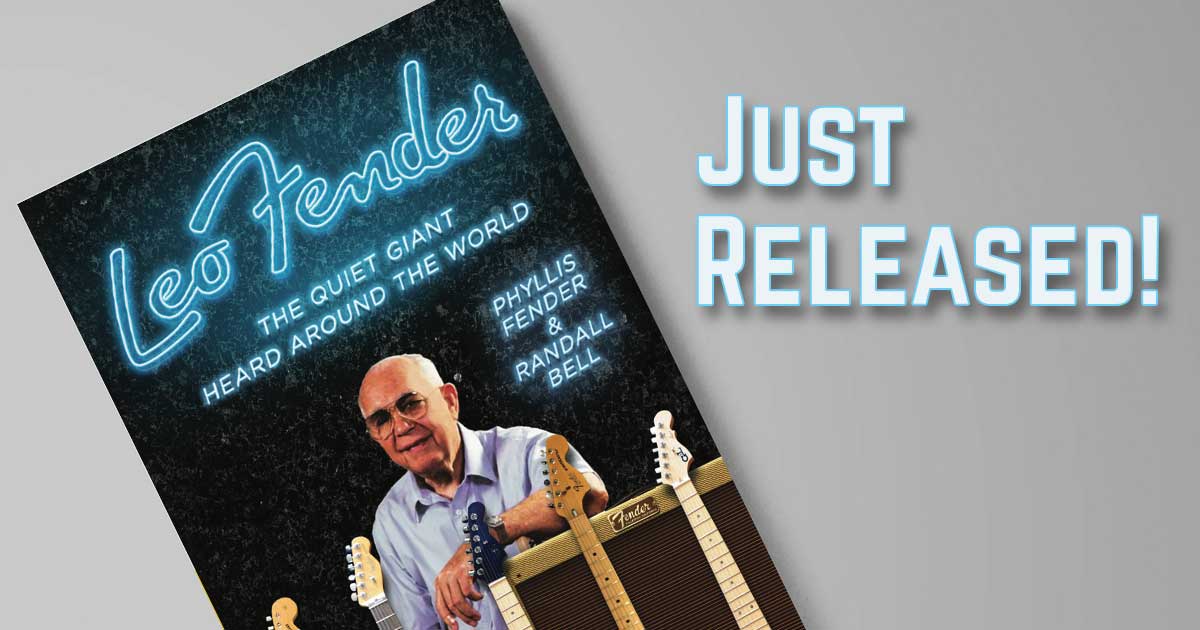
Reprinted with permission from Ascot Media Group Inc.
A Memory-Filled Journey Into The Life Of Guitar Legend Leo Fender
Fullerton, CA. ― The world occasionally produces one of those rare thinkers whose name becomes iconic.
Thomas Edison lit up the world; Albert Einstein profoundly altered the study of physics; Walt Disney reimagined entertainment; and Leo Fender invented the electric guitar.
Fender grew up in Fullerton, California, where his interest in electronics lead him to open his own radio repair shop in 1938. It wasn’t long before musicians and band leaders turned to him for help in repairing their equipment.
And the rest, as they say, is history.
Fender’s revolutionary guitar, the Fender Stratocaster, has been the preference of world-renowned musicians like Jimi Hendrix, Stevie Ray Vaughan, David Gilmour, Eric Clapton, George Harrison and Jeff Beck — to name a few.
While his name is synonymous with fist-pumping rock and roll sound, in reality, Fender was a shy, unassuming inventor who was nearly deaf and had one glass eye.
In 1946 he founded Fender Electric Instrument Manufacturing Company — the launch pad for his most iconic designs — and later on, G&L Musical Instruments.
 And now, his wife Phyllis Fender gives readers a memory-filled look into the wonderful world of this quiet genius in the book, Leo Fender: The Quiet Giant Heard Around the World. The book was co-written by Randall Bell, Ph.D., who grew up in Fender’s neighborhood and whose father was the head of the R&D department at Fender’s company.
And now, his wife Phyllis Fender gives readers a memory-filled look into the wonderful world of this quiet genius in the book, Leo Fender: The Quiet Giant Heard Around the World. The book was co-written by Randall Bell, Ph.D., who grew up in Fender’s neighborhood and whose father was the head of the R&D department at Fender’s company.
Fender’s game-changing contributions to the music world have been widely recognized. He was presented with the Country Music Association Pioneer Award in 1981; was inducted into the Country Music Hall of Fame, the Rock Walk of Fame and the Rock and Roll Hall of Fame. His accomplishments were also acknowledged with a Technical Grammy Award in 2009. Fender died in 1991.
Today, Fender is a household name. But the quirky, shy inventor never lived large or flaunted his fame. He lived in a mobile home, even after selling his company for $300 million (in today’s dollars). His daily routines and obsessions made him truly fascinating, and thanks to his enduring instruments, Fender’s legacy forever lives on.
Author Phyllis Fender volunteers at the Fullerton Museum where she shares with visitors stories about her life with Leo. She also serves as the Honorary Chairman of G&L. Twenty-two years ago, two different doctors told Phyllis that she had six months to live. Today, both of those doctors are dead, and she is here to finally tell this remarkable story.

Leo Fender: The Quiet Giant Heard Around the World
Read More ▼
Leo Fender: The Quiet Giant Heard Around the World
Eric Dahl
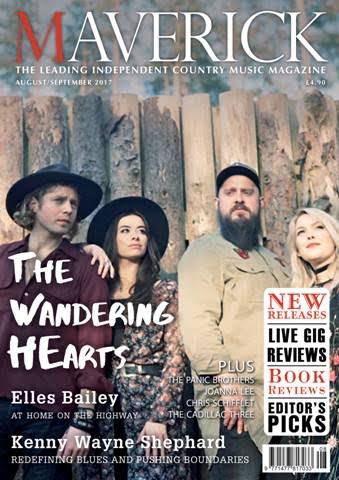
Few names in the world of guitars are more recognized than Fender. If Leo had stopped after creating the Telecaster he would still hold a secure place in guitar history. Not only is he in the Rock and Roll Hall of Fame, but Fender also received a Grammy Award, Cliffie Stone Pioneer Award and an ACM award.
The recently released book “Leo Fender - The Quiet Giant Heard Around the World” provides a different perspective on the music icon as written by his wife Phyllis Fender and Randall Bell (son of longtime Fender employee - Pete Bell). In the opening pages Phyllis explains that most of the book was conceived and written in Polly’s Pies in Fullerton, California not far from the G&L instruments factory, Leo’s last instrument company. Mrs. Fender and Leo were opposites as he was shy and reserved and she was outgoing and constantly talking, but that worked for them. She isn’t afraid to share deep dark secrets that the public never knew about Leo like that fact that as a child he fell off a truck on to a picket fence, lost his right eye and had a glass eye for the rest of his life. An Uncle that was also mechanically inclined and had a shop was the first person to feed Fender’s passion for taking apart things and putting them back together.
Most books state that he was not a musician but Phyllis informs us that as a youth he played piano, sax and trumpet. Leo’s first music equipment venture had nothing to do with guitars at all but a local band had asked him to build them a PA system, which led to creating five more. Considering how highly Fender’s instruments are thought of now, especially the vintage and pre-CBS models, it is interesting to know that when he first released them people laughed and scoffed at his guitars and called them boat paddles!
The chapter on Phyllis and Leo’s courtship is very touching and provides us a glimpse of a lonely and shy inventor that was need of companionship. It is also amazing that they got married on the actual Love Boat from the TV show and that Freddie and Tamar Travers played at the wedding!
Similar to geniuses like Steve Jobs of Apple, Leo had a regular daily routine and didn’t care for clothing choices so he limited them to primarily black pants, belt, socks and white or blue shirts. It seems that later in life with his marriage to Phyllis that his stepchildren and grandchildren bettered his life so it didn’t all revolve around his work. Leo was apparently very patriotic and was proud of the “Made in America” on the headstocks of his guitars. No guitars were brought home or kept at the Fender household, because Leo wanted them in the hands of musicians and he knew his next one would be even better.
Phyllis and Randall are both obviously proud of the legacy that Leo left behind. This book reads more like a personal journal with family photos interspersed between touching moments. Leo Fender – The Quiet Giant Heard Around the World, isn’t a guitar book but if you’re a fan of the man that invented them it is a must read!

Praise for Leo Fender from Keith Richards
Read More ▼
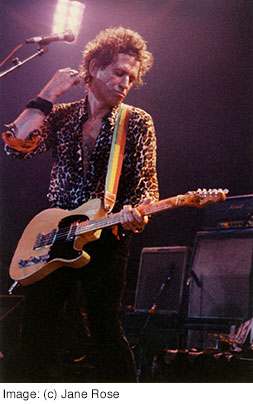
"When other companies made electric guitars, that is all they did. Leo had the whole concept in mind. He made an amplifier to match . It is, after all electric. This left the other guys with half an egg. So simple, so complete whether you prefer a stratocaster or a telecaster. If you used a Fender amp, you had the whole deal. Sturdy, reliable and beautifully made, they remain the standard that others strived to reach, let alone the BASS!!"
- Keith Richards

Praise for Leo Fender from Dave McLaren, CEO, G&L Musical Instruments
Read More ▼
"The Leo Fender legacy has continued for decades here at the G&L factory on Fender Avenue in Fullerton, California, where Leo’s office and laboratory remind us of his genius and passion for creating tools for musical expression. Though much has been written about his instruments, amplifiers and the musical revolution they fostered, precious little has been shared about this complex man who was brilliant yet humble, competitive yet compassionate, pragmatic yet spiritual. This book is an absolute must read for any music fan, a unique vantage point from which we can more richly understand and appreciate the father of modern music."
Dave McLaren, CEO, G&L Musical Instruments
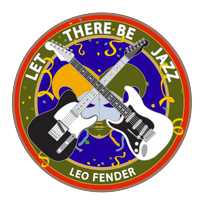

Praise for Leo Fender from Rob Schilling, Host of WINA’s The Schilling Show
Read More ▼
"As a longtime guitar player and the owner of many vintage Fender instruments and amplifiers, I was delighted to learn more about the man behind the legendary company. One of the “friendliest” signatures in the world, comes to life in this amazing behind-the- scenes glimpse into the life of Leo Fender."
- Rob Schilling, Host of WNA'S The Schilling Show

Praise for Leo Fender from Eric Dahl, FOX 17 Rock & Review
Read More ▼
"Many books have been written about Leo Fender and his marvelous musical inventions, but none have given us a glimpse into Fender's personal life. Phyllis Fender and Randall Bell have done an incredible job of humanizing the genius that was Leo Fender as his legacy continues!"
- Eric Dahl, FOX 17 Rock & Review

Praise for Leo Fender from Matt Gibney, The Stratosphere
Read More ▼
"A must read for any person who has ever plugged into an amplifier or dreamed of becoming an entrepreneur. We get a unique view under the hood of the selfless utilitarian genius who worked tirelessly around the clock up until his final days to perfect the craft. Phyllis Fender takes us behind the scenes of the man who worked famously behind the scenes for 1 reason alone- to serve the musician. A true underdog story"
- Matt Gibney, The Stratosphere

Praise for Leo Fender from Vaughn Skow, Vintage Guitar Magazine
Read More ▼
"This short yet captivating book is required reading for any true Fender affectionado. While much has been written about the work of Clarence Leonidas “Leo” Fender, precious little has been written about Leo Fender the man. This book is a game changer."
- Vaughn Skow, Vintage Guitar Magazine

Praise for Leo Fender from Bryan Locke, Program Director, Bowling Green's Classic Rock D93
Read More ▼
"You’ve heard of the Wizard of Waukesha? How about Leo the Lion from Fullerton? In the movie 'It's A Wonderful Life', George Bailey was shown by Clarence the Angel what things would have looked like had George never been born. I would hate to see what the world would look like without Leo Fender. A one-eyed radio repairman - born in a barn -transformed the world with one guitar. This is his story captured in an uncommon and absorbing way."
Bryan Locke
Program Director
WDNS Bowling Green KY
Bowling Green's Classic Rock D93
Daily News Broadcasting Co., Inc.

Praise for Leo Fender from Trevor English, Warehouse Guitar Speakers
Read More ▼
“Phyllis Fender provides a beautifully candid portrait of the humble genius we all know as the inventor of the electric guitar in “Leo Fender: The Quiet Giant Heard Around the World”. From losing an eye in a childhood accident, to achieving fame and fortune through his infamous inventions, Fender’s life had plenty of ups and downs. But the one thing that remained the same through all of it was Leo; unfaltering, stoic, and supremely dedicated to his craft."
- Trevor English, Warehouse Guitar Speakers


Leo Fender: The Quiet Giant Heard Around the World
Read More ▼
Leo Fender: The Quiet Giant Heard Around the World
Tara Low, Guitar Girl Magazine
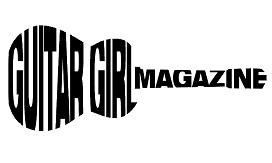 Leo Fender: The Quiet Giant Heard Around the World is a lovely tribute from Phyllis Fender to the simple, yet complex man that impacted the world of music. The reasoning behind the book? In the introduction, Mrs. Fender explains that there’s a plethora of books on the market today behind the iconic Fender guitar, but she wanted the world to learn more about the man that behind the guitar. This is her tribute to the man that amplified a solid body guitar, impacted the sound of music, and became a household name and iconic figure in the music industry.
Leo Fender: The Quiet Giant Heard Around the World is a lovely tribute from Phyllis Fender to the simple, yet complex man that impacted the world of music. The reasoning behind the book? In the introduction, Mrs. Fender explains that there’s a plethora of books on the market today behind the iconic Fender guitar, but she wanted the world to learn more about the man that behind the guitar. This is her tribute to the man that amplified a solid body guitar, impacted the sound of music, and became a household name and iconic figure in the music industry.
Co-written with Randall Bell, Ph.D., he and Mrs. Fender spent hours at Polly’s Pies in Fullerton, California sifting through documents and research and photos; and made notes of the memories they both shared from their time spent with Leo Fender. Dr. Bell grew up in the same neighborhood as the Fenders and his father was the head of the Research and Development Department, so he was very familiar with the life and times of Leo Fender.
This treasure of work walks us through Leo Fender’s life from his birth to his ultimate demise in 1991 recounting the memories he shared with her on his upbringing on a farm; his perseverance through physical disabilities; his education and relentless pursuit of gaining knowledge about anything mechanical; to taking a chance at opening his own radio repair shop after being laid off from several accounting jobs; becoming the inventor of amps and electric guitars that would dominate the music industry for years and still does; to his final days up to his death.
His meager beginnings were on a farm in Fullerton, California where he was born in 1909 to Clarence Monte Fender and Harriet Elvira Wood. From early on, his chores on the farm taught him the value of hard work. At the age of eight he had an accident where he lost an eye resulting in a glass eye. He was always tinkering with motors, clocks, old radio parts and batteries- and anything where a screwdriver was needed to open to peer inside. He attended public schools in Fullerton and pursued an accounting degree which would ultimately provide him with the financial knowledge needed to run an entire business.
After college, Leo worked for several companies in the accounting department, but was laid off from both because of the depression. That setback didn’t upset Leo as he wasn’t happy doing that type of work. He loved tinkering with and designing electronics. He married his first wife, Esther, in 1934, and in 1938 he borrowed $600 to start his own radio repair business in Fullerton.
And, so it began. With his burning desire for electronics and his love of acoustics and music, he began to design PA systems for local churches and musicians. Although he didn’t play guitar, he loved the way it sounded, but felt they needed to be heard more in a hall setting as the sound of the acoustic guitars were drowned out by the horn and brass instruments of the big bands popular at the time. He partnered with Doc Kauffman, an inventor, lap steel player, and employee of Rickenbacker to develop his first solid-body electric guitar. They began their company K & F Manufacturing Corporation.
And as they say, the rest is history. She goes on to tell the stories of the trials and errors of designing, patenting, and selling his guitars. Being a perfectionist, his guitars were made of high quality materials with exceptional electronics and garnered the attention of musicians around the world. The Telecaster was his first successful guitar and a few of the famous musicians that play his guitar are Buck Owens, Keith Richards, and Jimmy Page. He followed up with the Stratocaster which was played by Jimi Hendrix (Mrs. Fender acknowledged that Leo was not pleased with Jimi’s destruction of his beloved instruments), Elvis Presley (Leo wasn’t particularly fond of his provocative dance style), Stevie Ray Vaughan, and Eric Clapton just to name a few.
Basses and amps were also designed and perfected. The Fender Musical Instrument Corporation was formed in 1946, and Leo ultimately sold the company in 1965 to CBS due to his health. His wife Esther died of lung cancer in 1979. After his regained his health, he went on to create the G&L Musical Products in 1979 with George Fullerton. The company remains in business today carrying on Leo Fender’s mission.
Phyllis was introduced to Leo by mutual friends. Two completely opposite personalities collided creating a new family. Phyllis describes herself as outgoing, religious, talkative, and loves to hug. Leo was none of those, but she said he learned to love and expect those hugs. Never having children with Esther, Phyllis came with a family of three children and grandchildren, so it was an instant “big” family for Leo. For as quiet and reserved as he was on the outside, he loved that family and would even cry when the grandchildren would have to leave.
A very quiet man in the public eye, he rarely granted interviews nor gave or asked for autographs. It was apparent he was not in this for the money. A successful CEO of a major corporation would normally live lavishly in a mansion behind gated walls, spend thousands of dollars on a suit, drive expensive cars (if not being chauffeured around), and dine at the finest restaurants. But not Leo Fender. A night out at a restaurant was the Sizzler! He lived in a mobile home. He wore black pants, black shoes and socks, and either a white or blue shirt- complete with pocket protector and accessories. Phyllis says this is because he didn’t want to take the time to decide what to wear each day. He had work to do. His mind was constantly working- dreaming up his next design or how he could improve on current ones. So much so that at times it would be at the expense of vacations and family time. But Phyllis understood this man. And, so did those closest to him.
He was known to never raise his voice nor did he ever complain about his physical disabilities- besides having one glass eye, he was almost deaf due to an accident at the plant and had to wear hearing aids. Toward the end of his life, he had Parkinson’s and was unable to swallow on his own, had to be fed through a tube, and used a wheelchair. Phyllis was always by his side to take care of him.
He was a smart business man, entrepreneur, inventor, workaholic, humble, simple, unassuming, world-renowned individual, husband and father, and a Rock and Roll Hall of Fame Recipient, but it was his relentless pursuit of perfection and his deep love for music (and the angels that brought us that music) and his guitars that catapulted Fender to its iconic status that lives on today.
Phyllis Fender lovingly refers to Leo Fender throughout the book as “my Leo.” The book is not all about the guitars. It’s about Leo Fender the man. It’s easy to read, full of history, and features black and white photos throughout depicting the Fender Radio Repair shop in Fullerton, symbols of the Fender name throughout Fullerton, photos of the Fender plant, of his family and vacations, his office at the G&L plant which is exactly as he left it, and rock stars with Fender guitars. It ends with what they refer to as a “driving tour” of Fender’s life showing the schools he attended, the homes he lived in, and even his favorite “Sizzler” restaurant.
Reading this book, being involved in the music industry, and having lived in Southern California, I thoroughly enjoyed the photos and history of Fullerton. I recommend the book for anyone wanting to learn more about the man behind this iconic brand.
"Phyllis Fender lovingly refers to Leo Fender throughout the book as “my Leo.” The book is not all about the guitars. It’s about Leo Fender the man. It’s easy to read, full of history, and features black and white photos throughout. Reading this book, being involved in the music industry, and having lived in Southern California, I thoroughly enjoyed the photos and history of Fullerton. I recommend the book for anyone wanting to learn more about the man behind this iconic brand."
- Tara Low

Praise for Leo Fender from Geeks & Beats
Read More ▼
“As devotees of both music and technology, it was such a treat to dive into the world of Leo Fender with both Phyllis and Randall. Leo was a visionary who has changed the world of music – and technology – as we know it today. This book took us back in time, and really told stories in such a way that we felt that we were there. Thank you, Phyllis and Randall. We’re forever grateful for your storytelling and warm hearts!”
- Geeks & Beats

Praise for Leo Fender from Chris Beytes, editor, Ball Publishing
Read More ▼
“Any guitar player who appreciates Fender guitars and amps will appreciate learning more about the unusual man behind them, Leo Fender. This book, by Leo’s second wife, offers an admittedly biased view of Leo the single-minded inventor. While short on details about specific instruments and amps, it’s long on personal anecdotes and details of his life as only a loving wife can offer.”
Chris Beytes, editor, Ball Publishing (and proud owner of a ’57 Strat reissue)

Praise for Leo Fender from John Lafayette Ramey, musician, journalist.
Read More ▼
"The living embodiment of the American exceptionalism that won the Cold War and defined the 20th century, Leo Fender's life is essential knowledge for anyone who wishes to understand freedom in the United States, and in the world."
John Lafayette Ramey, musician, journalist.

Review for Leo Fender by David Jakubiak - fretmentor.com
Read More ▼
David Jakubiak, fretmentor.com
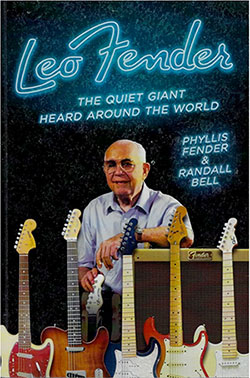 A Memory-Filled Journey Into The Life Of Guitar Legend Leo Fender
A Memory-Filled Journey Into The Life Of Guitar Legend Leo Fender
On November 1, 2017, a new book entitled “Leo Fender: The Quiet Giant Heard Around the World” will be released. I have had the chance to briefly review this book. The 180 page paperback gives an intimate portrayal of the life of Leo Fender. There are many intimate family and personal photos that have unlikely been seen by the general public before. This book is easy to read and it provides a useful summary of the life of Leo Fender.
So here is a little background on the man who is the father of the Fender Stratocaster guitar:
Fender, one of the first innovators of the electric guitar, grew up in Fullerton, California, where his interest in electronics lead him to open his own radio repair shop in 1938. It wasn’t long before musicians and band leaders turned to him for help in repairing their equipment. And the rest, as they say, is history.
Fender’s revolutionary guitar, the Fender Stratocaster, has been the preference of world-renowned musicians like Jimi Hendrix, Stevie Ray Vaughan, David Gilmour, Eric Clapton, George Harrison and Jeff Beck — to name a few.
While his name is synonymous with fist-pumping rock and roll sound, in reality, Fender was a shy, unassuming inventor who was nearly deaf and had one glass eye. In 1946 he founded Fender Electric Instrument Manufacturing Company — the launch pad for his most iconic designs — and later on, G&L Musical Instruments.
ender’s game-changing contributions to the music world have been widely recognized. He was presented with the Country Music Association Pioneer Award in 1981; was inducted into the Country Music Hall of Fame, the Rock Walk of Fame and the Rock and Roll Hall of Fame. His accomplishments were also acknowledged with a Technical Grammy Award in 2009. Fender died in 1991. Today, Fender is a household name. But the quirky, shy inventor never lived large or flaunted his fame. He lived in a mobile home, even after selling his company for $300 million (in today’s dollars). His daily routines and obsessions made him truly fascinating, and thanks to his enduring instruments, Fender’s legacy forever lives on.

Praise for Leo Fender from Bill Martinez, Radio Host, Bill Martinez Live
Read More ▼
"For every young boy like myself or young girl that was influenced by Rock 'n Roll, and maybe were even fortunate to own a Fender Guitar, the story and history of Leo Fender becomes personal. Leo's wife, Phyllis and Dr. Randall Bell reveal his subtle, humble and productive renown. Leo's gift and passion are the perfect story and example of when need meets invention. Rock 'n Roll was born and it needed a parent that would give it a signature sound and instrument. Iconic Fender guitars were born for Rock 'n Roll as much as Rock 'n Roll was born for Fender. As Phyllis Fender says, this is a love story of Leo and his kids and will cause you to fall in love with your Fender guitar again."
Bill Martinez, Radio Host, Bill Martinez Live


Praise for Leo Fender from Andy Mooney, CEO, Fender Musical Instruments
Read More ▼
"Leo once told Phyllis that all artists are angels and his job was to give them wings to fly. Leo’s vision has guided Fender for nearly 70 years. I think about what Leo said every morning on my way to the office and it makes me smile."
Andy Mooney, CEO, Fender Musical Instruments

Praise for Leo Fender from Valerie Milano, Editor, The Hollywood Times
Read More ▼
"With unwavering support from Randall Bell, Phyllis Fender’s book is a love letter to Leo Fender and to a bygone era. Through funny and intimate stories, she takes us to the man behind the Telecaster, the Stratocaster and the myriad of inventions that shaped music in the last half of the 20th century. Other books cover the inventions - this one dwells on their creator."
Valerie Milano, Editor, The Hollywood Times

Praise for Leo Fender from The Runaways
Read More ▼
"Where would we be without Leo Fender and electric guitars? Before Leo, there was no rock and roll. Because of the love that Leo had for all musicians, he allowed us to express ourselves.
We needed him so that we could form the world's first teenaged, all-girl punk rock band, and the Runaway's created a whole new dimension in music.
This world can indeed be a tough place, but the music makes it a better place. This book is beautifully written and lovingly executed. It sings a song that reveals the heart of this gentle soul. Leo clearly did not do it for money or fame, he did it for you and me. Leo was a gift from God. Rock on Leo. In the name of Leo Fender, "Long Live Rock n Roll!'"
Lita Ford, The Runaways

Phyllis Fender on Bill Martinez Live (MP3)
Read More ▼
Phyllis Fender on Bill Martinez Live (MP3)
 Bill Martinez Live Part 1
(28.8 MB)
Bill Martinez Live Part 1
(28.8 MB)
 Bill Martinez Live Part 2
(28.8 MB)
Bill Martinez Live Part 2
(28.8 MB)

Randall Bell on Accelerate! with Andy Paul (MP3)
Read More ▼

Interview with Phyllis & Randy on Roadhouse Radio 98.3 Vancouver
Read More ▼
Interview with Phyllis & Randy on Roadhouse Radio 98.3 Vancouver
 Roundhouse Radio 98.3 Vancouver
(28.8 MB)
Roundhouse Radio 98.3 Vancouver
(28.8 MB)
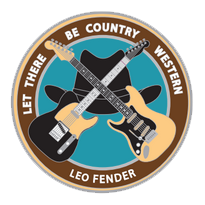

An Electric Legacy - Leo Fender: The Quiet Giant Heard Around the World
Read More ▼
An Electric Legacy - Leo Fender: The Quiet Giant Heard Around the World
Fern Cohen, Inspirational Media
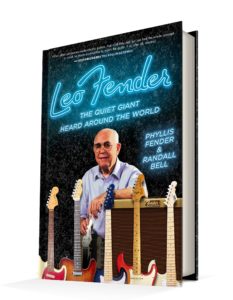 Anybody who has ever followed rock-n-roll, pop or country music, knows the name “Fender”. Just look closely at any guitar used by any musician on any stage or in any video and –even if you don’t see the brand-name of Fender — you can be sure that the electric guitar you’re looking at, wouldn’t be here today if not for Leo Fender.
Anybody who has ever followed rock-n-roll, pop or country music, knows the name “Fender”. Just look closely at any guitar used by any musician on any stage or in any video and –even if you don’t see the brand-name of Fender — you can be sure that the electric guitar you’re looking at, wouldn’t be here today if not for Leo Fender.
Thomas Edison lit up the world; Albert Einstein profoundly altered the study of physics; Walt Disney reimagined entertainment, and Leo Fender invented the electric guitar.
Fender grew up in Fullerton, California, where his interest in electronics led him to open his own radio repair shop in 1938. It wasn’t long before musicians and band leaders turned to him for help in repairing their equipment.
And the rest, as they say, is history.
Fender’s revolutionary guitar, the Fender Stratocaster, has been the preference of world-renowned musicians like Jimi Hendrix, Stevie Ray Vaughan, David Gilmour, Eric Clapton, George Harrison and Jeff Beck—to name a few.
While his name is synonymous with fist-pumping rock and roll sound, in reality, Fender was a shy, unassuming inventor who was nearly deaf and had one glass eye.
In 1946 he founded Fender Electric Instrument Manufacturing Company—the launch pad for his most iconic designs—and later on, G&L Musical Instruments.
And now, his wife Phyllis Fender gives readers a memory-filled look into the wonderful world of this quiet genius in the book, Leo Fender: The Quiet Giant Heard Around the World. The book was co-written by Randall Bell, Ph.D., who grew up in Fender’s neighborhood and whose father was the head of the R&D department at Fender’s company.
Fender’s game-changing contributions to the music world have been widely recognized. He was presented with the Country Music Association Pioneer Award in 1981; was inducted into the Country Music Hall of Fame, the Rock Walk of Fame and the Rock and Roll Hall of Fame. His accomplishments were also acknowledged with a Technical Grammy Award in 2009. Fender died in 1991. Today, Fender is a household name. But the quirky, shy inventor never lived large or flaunted his fame. He lived in a mobile home, even after selling his company for $300 million (in today’s dollars). His daily routines and obsessions made him truly fascinating, and thanks to his enduring instruments, Fender’s legacy forever lives on. Author Phyllis Fender volunteers at the Fullerton Museum where she shares with visitors stories about her life with Leo. She also serves as the Honorary Chairman of G&L. Twenty-two years ago, two different doctors told Phyllis that she had six months to live. Today, both of those doctors are dead, and she is here to finally tell this remarkable story.

Q&A: Phyllis Fender
Read More ▼
Q&A: Phyllis Fender
W.A. Demers

Leo Fender did more than invent the electric guitar; he altered the trajectory of the music world. Would the sounds of iconic musicians like Jimi Hendrix, Stevie Ray Vaughn, Eric Clapton and Jeff Beck be the same if they hadn’t played Fender Stratocasters? Phyllis Fender, wife of the late inventor, is giving the world a rare look into the sometimes quirky – and always fascinating – life of this soft-spoken man in Leo Fender: The Quiet Giant Heard Around the World , with co-author Randall Bell, PhD.
Did your husband actually invent the electric guitar? Did he ever learn to play one?
Paul Bixby, Les Paul and some people at Rickenbacker – who were all friends of Leo’s – were putting pickups and microphones on acoustic guitars as far back as 1938. Until Leo, every guitar was hollow. In the mid-1940s, Leo got the idea to put pickups on a solid piece of wood, which is the modern electric guitar. Guitar Player Magazine declared that Leo Fender was the father of the modern electric guitar. Leo not only could not play a guitar, but he could not even tune a guitar! Leo got his joy from inventing and designing, and he loved guitar players and just wanted to support them.
Did he have any memorable interactions with any of the world-renowned musicians who played his guitar?
Every imaginable country and rock star came to the plant when they were performing at the Anaheim Stadium or the Convention Center – or they would come down from Hollywood. Leo did not pay much attention to “who” they were, he was more interested in “what” they could do with the guitar. Leo never asked for autographs or pictures. For him, it was all business – not a “meet and greet” event.
Bios characterize Leo Fender as an unassuming and shy genius. What was the cause?
Leo was quite shy naturally, and the fact that he had a glass eye and was deaf did not help the cause. He was shy, which some people mistook as being snobby, but he was not a snob at all. He just loved to focus all his energy on designing guitars. He felt that the world would be better with lots of music.
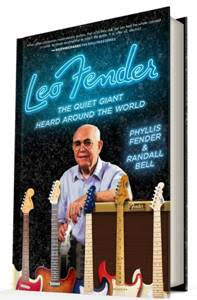
What did Randall Bell bring to this project?
Randy grew up in our neighborhood and his dad worked at Fender as the head of the research and development department. Randy also plays the guitar, and he knows all the details about the history of music, Fender and G&L. He is also a beautiful writer. For months, Randy and I met at a special booth at Polly’s Pie on Raymond, just by the plant where Leo invented the Stratocaster. We met in our special “office” just about every week, and Randy would ask lots of questions and record my answers for hours at a time. (I do love to talk!) We poured over photo albums, Leo mementoes, guitars and drove all over Fullerton looking at Leo sites. The process was so much fun. Randy just loves Leo, and I think it shows in the way the book came out.
You have your own remarkable story, going back to a doctor’s prognosis more than two decades ago. Can you tell us about it?
I have a heart condition and the doctors told me that my heart was only 17 percent efficient. The first doctor told me that I had three to six months to live. So, I went to another doctor who told me the same thing. Today, both of those doctors are dead! I really cannot explain why I keep ticking, other than Leo and God are looking down and wanted me to get this story out!
In addition to the early guitars themselves, which bring record prices at auction, there must be an incredible amount of Fender ephemera, including catalogs, ads and promotional items. Where does the bulk of it reside? Gladly it mostly resides at the Fullerton Museum, so that everyone can come and enjoy it! The people at the museum are wonderful and they have a permanent Leo Fender display. It has the first guitar that Leo created, all the way to the last one he invented the day before he died … and a whole bunch more in between!
When will your book be released?
The book can be pre-ordered on Amazon and comes out the first week of November in time for Christmas. I am hand-signing all the books that are pre-ordered – I have thousands of them on my kitchen table right now! The Fullerton Museum is hosting a big event on November 17, where I will talk about Leo and sign books.

Leo Fender: The Quiet Giant Heard Around the World
Read More ▼
Leo Fender: The Quiet Giant Heard Around the World
A Memory-Filled Journey Into The Life Of Guitar Legend Leo Fender
Frank McMillian
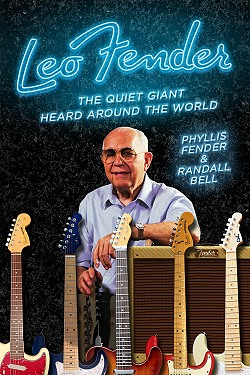 The world occasionally produces one of those rare thinkers whose name becomes iconic. Thomas Edison lit up the world; Albert Einstein profoundly altered the study of physics; Walt Disney reimagined entertainment; and Leo Fender invented the electric guitar.
The world occasionally produces one of those rare thinkers whose name becomes iconic. Thomas Edison lit up the world; Albert Einstein profoundly altered the study of physics; Walt Disney reimagined entertainment; and Leo Fender invented the electric guitar.
Fender grew up in Fullerton, California, where his interest in electronics lead him to open his own radio repair shop in 1938. It wasn't long before musicians and band leaders turned to him for help in repairing their equipment. And the rest, as they say, is history.
Fender's revolutionary guitar, the Fender Stratocaster, has been the preference of world-renowned musicians like Jimi Hendrix, Stevie Ray Vaughan, David Gilmour, Eric Clapton, George Harrison and Jeff Beck — to name a few. While his name is synonymous with fist-pumping rock and roll sound, in reality, Fender was a shy, unassuming inventor who was nearly deaf and had one glass eye.
In 1946 he founded Fender Electric Instrument Manufacturing Company — the launch pad for his most iconic designs — and later on, G&L Musical Instruments. And now, his wife Phyllis Fender gives readers a memory-filled look into the wonderful world of this quiet genius in the book, Leo Fender: The Quiet Giant Heard Around the World. The book was co-written by Randall Bell, Ph.D., who grew up in Fender's neighborhood and whose father was the head of the R&D department at Fender's company.
Fender's game-changing contributions to the music world have been widely recognized. He was presented with the Country Music Association Pioneer Award in 1981; was inducted into the Country Music Hall of Fame, the Rock Walk of Fame and the Rock and Roll Hall of Fame. His accomplishments were also acknowledged with a Technical Grammy Award in 2009. Fender died in 1991.
Today, Fender is a household name. But the quirky, shy inventor never lived large or flaunted his fame. He lived in a mobile home, even after selling his company for $300 million (in today's dollars). His daily routines and obsessions made him truly fascinating, and thanks to his enduring instruments, Fender's legacy forever lives on.
Author Phyllis Fender volunteers at the Fullerton Museum where she shares with visitors stories about her life with Leo. She also serves as the Honorary Chairman of G&L. Twenty-two years ago, two different doctors told Phyllis that she had six months to live. Today, both of those doctors are dead, and she is here to finally tell this remarkable story.
The review provided by Ascot Media Group [Website]

New book offers personal look into the life of Leo Fender, creator of Fender guitars.
Read More ▼
New book offers personal look into the life of Leo Fender, creator of Fender guitars
Nedra Rhone
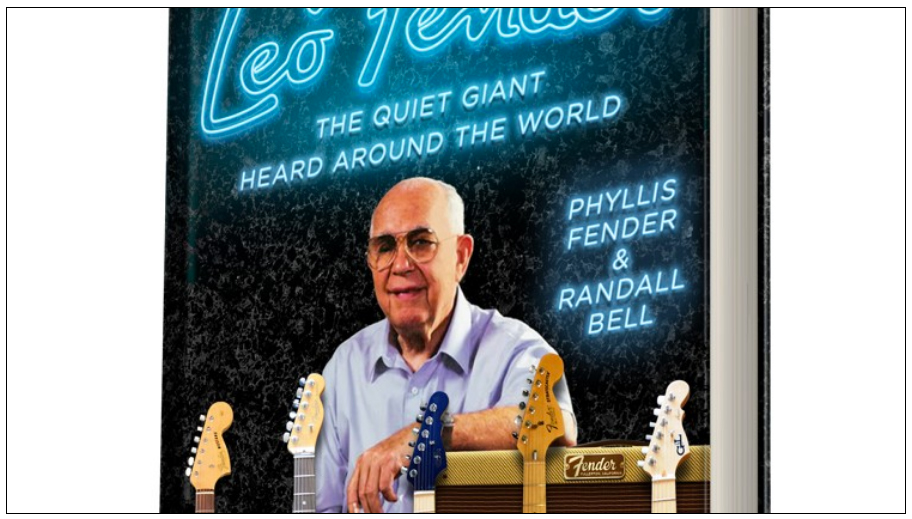
Leo Fender, maker of Fender guitars, famously never learned how to play a guitar. He also couldn't dance. And after a freak accident with an amplifier, he lost most of his hearing. But the man known as the "quiet giant" was very much a lover of music and believed it was his calling to help musicians, said his wife Phyllis Fender in a new memoir to be released on Nov. 1.
"Leo Fender: The Quiet Giant Heard Around the World," (Leadership Institute Press, $25) was written by Fender's second wife and Randall Bell, son of Pete Bell, who led Fender's research and development department.
Fender died in 1991 at age 81 after having a heart attack at home. He had also suffered from Parkinson's Disease and was confined to a wheelchair, but he insisted on working right up until the day he died.
Weaving together stories from personal and professional memories, Fender and Bell describe how Leo Fender revolutionized music by ushering the electric guitar into the mainstream. While Fender and his factory were firmly ensconced in Fullerton, Calif., where he was born and raised, his instruments would make history worldwide, even leaving a mark in Georgia.
In 1973 the band Lynyrd Skynyrd recorded that famous backing of "Sweet Home Alabama" at a studio in Doraville with a borrowed amp turned up at full volume and a 1972 Fender Stratocaster which has been displayed at the Rock and Roll Hall of Fame Museum in Cleveland, Ohio.
Decades later in 2005, it was again a Fender Stratocaster that set a new record for music memorabilia when it sold for $2.7 million. More than 300 custom-color Fender guitars are on display at Songbirds Guitar Museum in Chattanooga, Tenn.
"Every guitar player has (a Fender) in the arsenal," said Atlanta-based Greg Mayo, owner of Gregsguitars.net , an online shop for vintage guitars. "Leo wasn’t the first person to make and design an electric guitar. An electrified guitar of some sort had already been in existence, but not a solid body guitar with a reliable pick up system and a good neck you could actually play in a band," Mayo said.
But when Fender, a former accountant turned radio shop owner turned guitar designer, introduced his creation to market in 1946, everyone laughed and called them "boat paddles," said Phyllis Fender. It would take a few more years, but when Fender released the Telecaster, it became an immediate hit. The in 1954, came the iconic Stratocaster. Fender owned his eponymous business for almost 20 years before selling it to CBS in 1965.
Though he never publicly admitted to it, Phyllis Fender notes that her husband regretted selling his company. He had agreed to the sale fearing he was going to die from a staph infection, she said. He lived and would remain at Fender as a consultant for many years, but his wife said he confessed to her many times that he regretted the sale.
Fender was a very private person. He was frugal except for his passion for boats. He shunned the spotlight and rarely met with musicians, though they all clamored to meet him, said his wife. He was a workaholic, who once ended a vacation because he had an idea for a new design. He didn't have the best skills with people, she said, mostly because he reserved his energy for instruments.
When he was designing guitars, Fender would watch how musicians handled their instruments and scribble notes. He would loan out instruments and ask for feedback. He poured so much of himself into creating his guitars and despite their popularity with rock and roll artists, Fender was partial to country western. His favorite musician was Glenn Campbell, Phyllis Fender said.
For Fender, the guitars were the thing. He would make special ones for musicians, such as a red, white and blue one for Buck Owens or the purple one that Prince asked him to promise not to make for anyone else, but he never kept a single one of his guitars for himself.
"The next one I build is going to be so much better," Phyllis Fender said he would tell her. "Why would I keep something that was obsolete?"
It was typical of Fender to make such a statement and his wife acknowledged that it made sense, but his instruments can hardly be considered obsolete.
"Wherever you go in the world, if you see the silhouette of a Stratocaster, you know what it is. They got it right. All they have done is refine the product," Mayo said. "Every guitar that has been made since then is a different take on what Fender did back in the 1950s."

Praise for Leo Fender from Jeff Penczak, Shindig Magazine
Read More ▼
LEO FENDER: THE QUIET GIANT HEARD AROUND THE WORLD
Phyllis Fender & Randall Bell
***
Leadership Institue Press
Leo’s second wife and the head of his R&D department’s son collaborated on this folksy eulogy to the father of the electric guitar and bass. Clarence Leonidas Fender was born in a barn on a farm in Fullerton, California in 1909. A hard, honest work ethic instilled at an early age helped see him through numerous tragedies (he lost an eye at 7, went deaf from a shop accident, and suffered from Parkinson’s disease and palsy). He not only couldn’t play guitar, he couldn’t even tune one. Yet 91 of Rolling Stone’s Top 100 guitarists used a Fender (the other 9 played knockoffs!), and the highest amount ever paid for a piece of musical memorabilia was £1.6 million (in 2005) for one of his Stratocasters.
This cursory biography covers Leo’s final decade, so you won’t find many insights into his designs or inspirations. Phyllis tells us he preferred country music over rock, jazz, and blues (Glen Campbell was his favourite guitarist; he hated what Hendrix did to “his babies”.) He liked simple things; he was a Conservative millionaire patriot who was as proud of the “Made in the USA” stamp on his guitars as his own name. He drove old cars (owned two in case the battery on one of them died), wore simple black clothes, and lived in a trailer park. He gave cans of special tuna fish as Christmas presents, and went on ocean cruises, but preferred taking pictures of the engines and designing more guitars. You’ll find all this and more about his daily routines, quirks, habits, friendship with Les Paul, and the mysterious last guitar he ever made inside this fond recollection.
Jeff Penczak

Randall Bell on Liberty Watch Radio (MP3)
Read More ▼


A Memory-Filled Journey Into the Life of Guitar Legend Leo Fender
Read More ▼
A Memory-Filled Journey Into the Life of Guitar Legend Leo Fender
Free Bird Times Publishing Co.
 Fullerton, CA, The world occasionally produces one of those rare thinkers whose name becomes iconic.
Fullerton, CA, The world occasionally produces one of those rare thinkers whose name becomes iconic.
Thomas Edison lit up the world; Albert Einstein profoundly altered the study of physics; Walt Disney reimagined entertainment; and Leo Fender invented the electric guitar.
Fender grew up in Fullerton, California, where his interest in electonics lead him to open his own radio repair shop in 1938. It wasn't long before musicians and band leaders turned to him for help in repairing their equipment.
And the rest, as they say, is history
Fender's revolutionary guitar, the Fender Stratocaster, ahs been the preference of world-renowned musicians like Jimi Hendrix, Stevie Ray Vaughan, David Gilmour, Eric Clapton, George Harrison and Jeff Beck - to name a few.
While the name is synonymous with fist-pumping rock and roll sound, in reality, Fender was a shy, unassuming inventor who was nearly deaf and had one glass eye.
In 1946 he founded Fender Electric Instrument Manufacturing Company - the launch pad for his most iconic designs - and later on, G&L Musical Instruments.
And now, his wife Phyllis Fender gives readers a memory-filled look into the wonderful world of this quiet genius in the book, Leo Fender: The Quiet Giant Heard Around the World. The book was co-written by Randall Bell, Ph.D, who grew up in Fender's neighborhood and whose father was the head of the R&D department at Fender's company.
Fender's game-changing contributions to the music world have been widely recognized. He was presented with the Country Music Association Pioneer Award in 1981; was inducted into the Country Music Hall of Fame, the Rock Walk of Fame and the Rock and Roll Hall of Fame. His accomplishments were also acknowledged with a Technical Grammy Award in 2009. Fender died in 1991.
Today, Fender is a household name. But the quirky, shy inventor never lived large or flaunted his fame. He lived in a mobile home, even after selling his company for $300 million (in today's dollars). His daily routines and obsessions made him truly fascinating, and thanks to his enduring instruments, Fender's legacy forever lives on.
Auther Phyllis Fender volunteers at the Fullerton Museum where she shares with visitors stories about her life with Leo. She also serves as the Honorary Chairman of G&L. Twenty-two years ago, two different doctors told Phyllis that she ahd six months to live. Today, both of those doctors are dead, and she is here to finally tell this remarkable story.
LEO FENDER
The Quiet Giant Heard Around the World
Leadership Institute Press
ISBN-10:0996793143
ISBN-13: 978-0996793148

The story of Leo Fender - creator of iconic guitars
Read More ▼
The story of Leo Fender - creator of iconic guitars
ETC magazine (Eastbourne edition)
Jeanne Monk reviews The Memoir ‘Leo Fender: The Quiet Giant Heard Around The World’ about American inventor and manufacturer of electronic musical instruments Leo Fender (who died in 1991). Fender developed the first mass-produced solid-body electric guitar and was to forever alter the music world with his invention of the Fender Stratocaster, (& Telecaster, etc). His wife Phyllis Fender shares her personal stories of this quiet genius in this enthralling memoir... Jeanne Monk discovers that “occasionally, the world produces one of those rare thinkers that alter the course of history” (line taken from book) – one such person was Leo Fender.
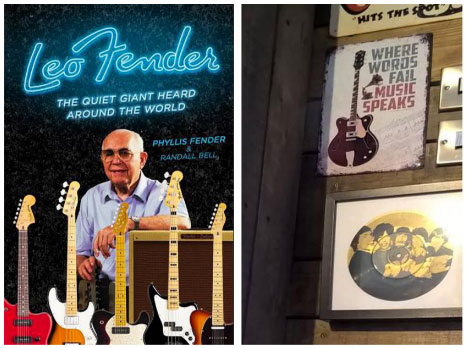 “Thomas Edison lit up the world with the light bulb, Albert Einstein altered the study of physics, Walt Disney reinvented entertainment, and Leo Fender invented the electric guitar.”
“Thomas Edison lit up the world with the light bulb, Albert Einstein altered the study of physics, Walt Disney reinvented entertainment, and Leo Fender invented the electric guitar.”
A new book called ‘Leo Fender: The Quiet Giant Heard Around The World’ written by his wife Phyllis Fender, with Randall Bell (published by Leadership Institute Press, available for pre-order on Amazon from 1 November 2017), chronicles the life and times of the creator of the iconic Fender guitars, Leo Fender. Over the years, he was to win many awards including a Grammy Award, Academy of Country Music Awards, a Cliffie Stone Pioneer Award, as well as being inducted into the Country Music Hall of Fame and the Rock and Roll Hall of Fame.
The book tells us he was born in Anaheim and raised in Fullerton, and from an early age, he showed an interest in tinkering with electronics. In 1938, he opened his own radio repair shop, called Fender Radio Service. Within a few years, he founded Fender Electric Instrument Manufacturing Company – the launch pad for his most iconic designs – and later on, G&L Musical Instruments. “He was fascinated with designing, inventing, and building,” said Phyllis. Fender’s revolutionary guitar, the Fender Stratocaster, has been the preference of world-renowned musicians like Jimi Hendrix, Stevie Ray Vaughan, David Gilmour, Eric Clapton, George Harrison, Buddy Holly, and Jeff Beck – to name but a few.
The birth of the first electric guitar really came about when Fender was listening to a band made up of brass section, drums, and guitarists. It occurred to him that the guitarists playing their wooden acoustic guitars could not be heard. “While they were playing with all their might, nobody could hear them (over the other sounds from the band)...they were basically invisible. The guitarists had to be heard.” While Fender’s name is synonymous with fist-pumping rock and roll sound, in reality, Fender was a shy, unassuming inventor who was nearly deaf and had one glass eye.
Twenty-five years after his death, Leo Fender’s name is still as resonant as it always was. I asked Phyllis Fender (with Randall Bell) why she wanted to tell this remarkable story.
“There have been lots of wonderful books written about Leo’s guitars. This book is less about guitars, but more about Leo himself. I wanted to tell the story because Leo was so shy. He rarely spoke about himself, yet his life is so remarkable. I simply wanted the world to know about this genius mind. He also loved guitars and really got excited to see guitar players get to express their individual music.”
Throughout the book, it is clear that Leo worked hard and if he really wanted something, he could achieve it. His guitars, which were his own inventions, played by artists gave him immense pleasure. Indeed, ‘Guitar Aficionado’ reported: “No guitar represented a greater convergence of artist, event, and instrument than the 1968 Fender Stratocaster played by Jimi Hendrix at ‘Woodstock’” (where he performed for over two hours). Checking the web for other artists who played his guitars, I found that Glen Mattock, the original Bassist in the ‘Sex Pistols’ Band (with lead singer John Lydon, later rechristened ‘Johnny Rotten’), played a Fender Precision Bass in 1975/1976.
I asked Phyllis what Fender thought of the artists who played his guitars.
“Leo only liked country, western music. However, he loved all musicians. He really did. Even if you did not like the music. If he did not enjoy the music, he simply turned his hearing aids off and enjoyed the techniques. He also loved to see the audience enjoy themselves,” she said. The birth of the electric guitar is a profound story with Leo Fender at the forefront. “I genuinely cannot think of anything that we left out of this book,” said Phyllis.
Finally, eating at the Custom Café recently (Barnhorn Road, Pevensey Levels National Park in East Sussex), I saw a picture of the Gretsch guitar (one of Fender’s brands distributed under license) played by artists such as Chet Atkins. It seems the Fender brand is everywhere!
Copyright Jeanne Monk © December 2017. Picture courtesy: Front cover of book Ascotmedia Group; picture of Gretsch guitar from The Custom Café

Leo Fender: The Quiet Giant Heard Around The World
Read More ▼
Leo Fender: The Quiet Giant Heard Around The World
by Phyllis Fender and Randall Bell
Written by Debra C. Argen
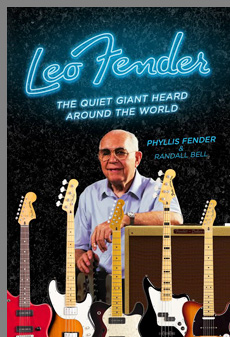 Writing about music since college, when I saw the book, Leo Fender: The Quiet Giant Heard Around The World written by Phyllis Fender and Randall Bell, I knew that it was a book I wanted to read, as guitarists have long cherished Fender guitars. Written by Leo Fender's widow, Phyllis Fender, and Randall Bell, who grew up in the same neighborhood as the Fenders, and whose father worked for the Fender company, the book is filled with fun, personal anecdotes and photos that humanize the creative genius who left his mark on the world and forever changed the sound of music and electric guitars.
Writing about music since college, when I saw the book, Leo Fender: The Quiet Giant Heard Around The World written by Phyllis Fender and Randall Bell, I knew that it was a book I wanted to read, as guitarists have long cherished Fender guitars. Written by Leo Fender's widow, Phyllis Fender, and Randall Bell, who grew up in the same neighborhood as the Fenders, and whose father worked for the Fender company, the book is filled with fun, personal anecdotes and photos that humanize the creative genius who left his mark on the world and forever changed the sound of music and electric guitars.
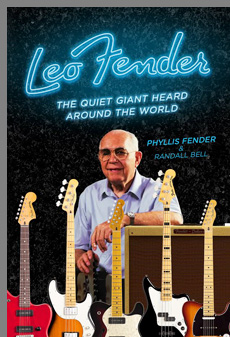
Leo Fender - The Quiet Giant Heard Around The World by Phyllis Fender and Randall Bell
After reading the book, I wanted to learn more and interviewed Phyllis Fender and Randall Bell. First and foremost, Phyllis Fender is an absolute delight, and her charm, and her humor, come across in her personal stories about Leo. Together with Randall Bell, PhD, they have created an interesting book about Leo Fender, a man who changed the world for guitarists and the world of music with his inventions.
Described as a "tinkerer" who went to school for accounting before turning a hobby of fixing things into a lifetime career, Leo was someone who was interested in how things worked, how he could make them better, and improve the music for musicians. Interesting to note is that Leo, the man who created Fender guitars and changed the world of music, was not a musician, he had sight in only one eye due to an accident on his family's farm as a child, and was partially deaf due to an accident at work.
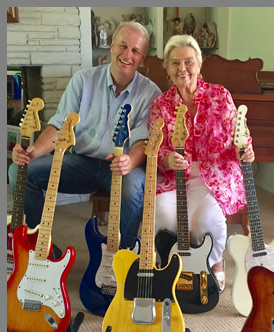
Randall Bell and Phyllis Fender
Speaking with Phyllis, she said that the inspiration for the book came from her desire to show the private Clarence Leo Fender (1909-1991), the one that she knew, from the public Leo. When Phyllis, a charming fireball of energy, married widowed Leo in 1980 (his wife Esther had died of cancer in 1979), a shy, quiet man, whose only "children" were his guitars and who was totally absorbed in his work, he instantly became a stepfather, son-in-law, uncle, and grandfather, who grew to love her large family.
When Phyllis met Randall Bell, whose father had worked for the Fender company, he encouraged her to write the book, during which they had a lot of fun, which comes shiningly across with interesting stories about Leo at work, his love for musicians and his interaction with them, her travels with Leo around the world, and the family-man Leo.
Leo Fender founded his company, Fender Electric Instrument Manufacturing Company in 1946, and sold it in 1965, due to a prognosis that he was very ill and did not have long to live. Like everything Leo did, he surprised the doctors, and lived. For guitarists, a Fender guitar, including the Telecaster® and the Stratocaster® has long been a status symbol for guitarists Jimi Hendrix, The Jacksons, Buddy Holly, Jimmy Page, Elvis Presley, Eric Clapton, Stevie Ray Vaughan, David Gilmour, George Harrison, Jeff Beck, and the long list goes on. Through his creations, he changed not only the way rock guitarists played, but also changed the world for country western musicians as well.
Healthy again and wanting something to do, Leo went on to create another company, G & L, with George Fullerton, once again adding to the world of music with his iconic designs and inventions. Leo Fender has indeed left his mark on the world, he received a Country Music Association Pioneer Award in 1981, was inducted into the Country Music Hall of Fame, the Rock Walk of Fame, the Rock and Roll Hall of Fame, and received a posthumous Technical Grammy® in 2009.
Whether you are a guitarist, just love music, are a "tinkerer," or are looking for an entertaining read, Leo Fender: The Quiet Giant Heard Around The World by Phyllis Fender and Randall Bell, is sure to delight. In closing, still writing about music, at every performance I go to now, I always look for Fender guitars.
If you are going to be in Fullerton, California, be sure to visit the City of Fullerton Museum to experience their Leo Fender Gallery to learn more about: Leo Fender: Life and Legacy. As an added treat, Phyllis Fender is a docent in the Fender Gallery where she tells stories about Leo and how he loved to laugh, and said that when the gallery is full of people having fun and laughing, she thinks, Leo, this is for you.
On November 17, 2017, Phyllis, along with Randall Bell will be at the museum for their launch and book signing of Leo Fender: The Quiet Giant Heard Around The World written by Phyllis Fender and Randall Bell.

Lovers of Strumming Gather for Festivals
Read More ▼
Lovers of Strumming Gather for Festivals
by Debra Bokur

Each year, an estimated 2,000 guitar shows and festivals take place at locations worldwide. This year, May 4–6, the 41st Annual Dallas International Guitar Festival will be held at Dallas Market Hall, where all things guitar are the focus. Collectors, dealers, vintage masterpieces, celebrities and music lovers gather for an extravaganza that got its unpretentious beginnings in 1978 in a Dallas hotel room. In Iserlohn, Germany, July 22–29, the 27th International Guitar Competition Iserlohn 2018 will include evening concerts, more than 600 individual lessons, a lecture series and a guitar orchestra with England’s Gerald Garcia. In the fall, Clonakilty, West Cork, Ireland, will be host to the Clonakilty International Guitar Festival. Dates are Sept. 19–23, with program details available later this year.
Tune up before packing for your festival of choice with the newly released Leo Fender: The Quiet Giant Heard Around the World — A Chance to Know the Man Behind the Legacy (Leadership Institute Press, 2017). Penned by Fender’s wife Phyllis Fender and Randall Bell, Ph.D., this riveting memoir offers an inside look at the unpretentious, shy genius who would become the creator of the Fender electric guitar, the instrument favored by Jimi Hendrix, Eric Clapton, Jeff Beck, Stevie Ray Vaughan, George Harrison and others who rank as some of the world’s most accomplished musicians. Fender, who passed away in 1991, founded the Fender Electric Instrument Manufacturing Company in 1946, as well as G&L Musical Instruments. Despite the fact he garnered a host of prestigious awards and his company became worth hundreds of millions of dollars, Fender continued to live in a modest mobile home. The book reveals mesmerizing details of his life, idiosyncrasies and work — the perfect prelude to listening to musicians playing the Fender guitar live on stage.

The Leo Fender Music Revolution
Read More ▼
The Leo Fender Music Revolution
Audrey T. Hingley
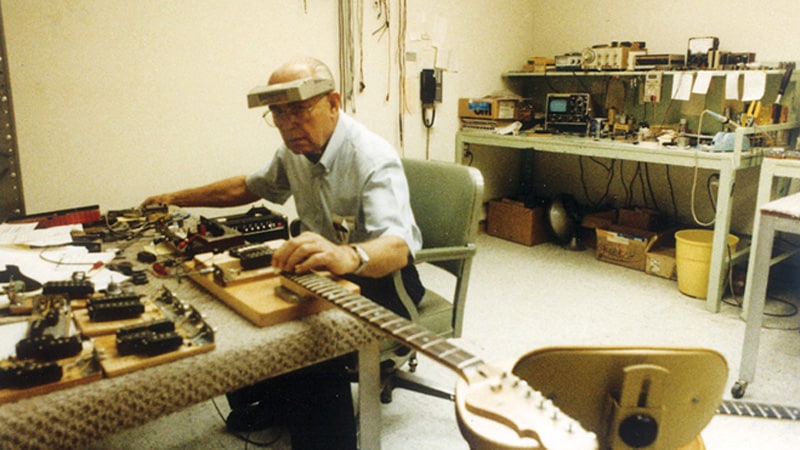
A shy farmer’s son with an accounting degree, Leo Fender couldn’t play or even tune a guitar. A workaholic, he was nearly deaf and had a glass eye. Despite a fortune amassed through his inventions, he dressed like the factory workers at his business. He looked like a guy who might run a gas station rather than the multimillionaire he became.
Yet this unassuming man revolutionized music, first with the creation of his renowned solid-body electric guitar (the Fender Telecaster, aka Esquire and Broadcaster, 1950), and the now-legendary Fender Stratocaster (1954). He also invented the electric bass guitar, known as the Fender Precision Bass or P-Bass (1951) and the Fender Bassman amplifier (1952).
Leo’s guitars went on to be played by people like Buddy Holly, Chuck Berry, Elvis, Bob Dylan, Jimi Hendrix and Eric Clapton. He built a music empire, first with Fender Electric Instrument Manufacturing Company and later with G & L Guitars, both in Fullerton, California, his lifelong home.
He was inducted into the Rock & Roll Hall of Fame and received a posthumous Grammy in 2009 for “contributions of outstanding technical significance to the recording field.” In 2005, a Fender Stratocaster set the record for music memorabilia, selling for $2.7 million at a charity auction.
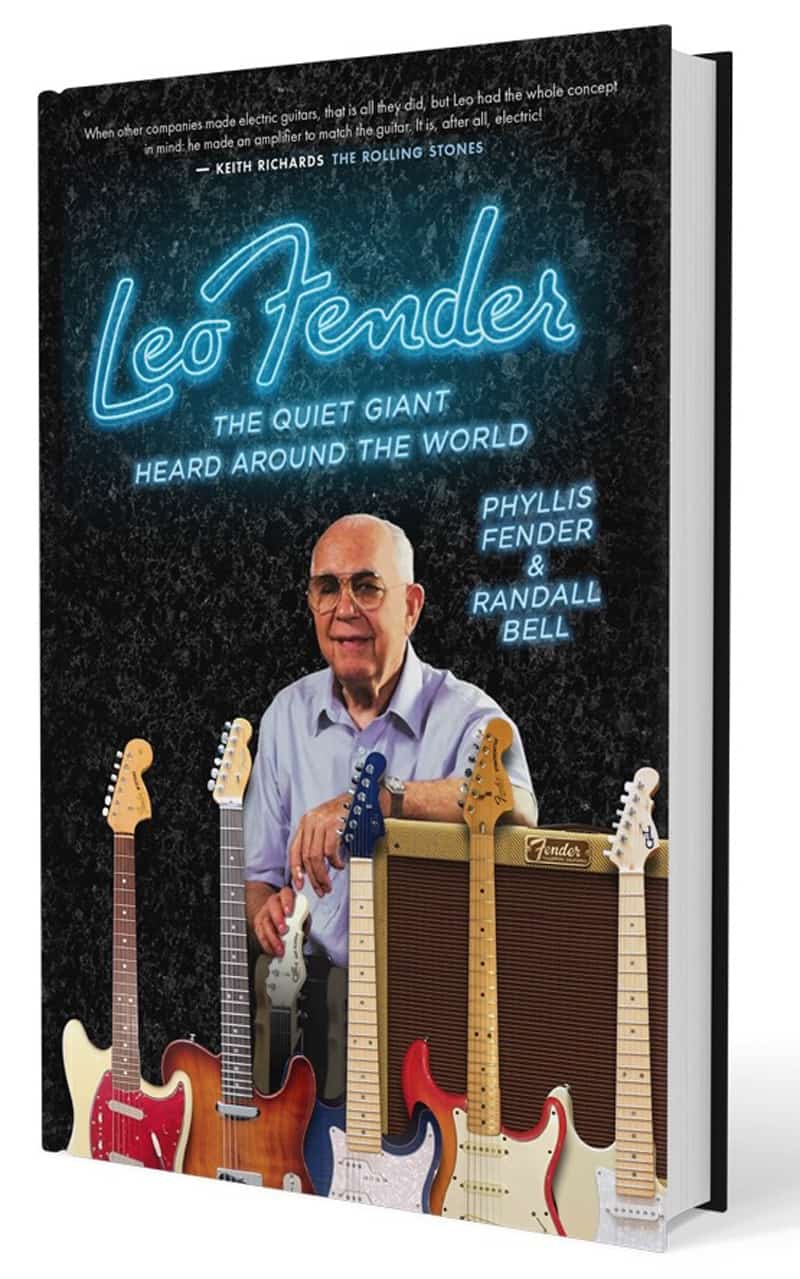 AMPLIFYING FENDER’S STORY
AMPLIFYING FENDER’S STORY
Leo Fender’s widow, Phyllis, and co-author Randall Bell, Ph.D., have penned a new book, Leo Fender: The Quiet Giant Heard Around the World. Phyllis, a docent at Fullerton Museum in California, where a permanent display honors Leo, explains, “I was amazed at how interested people are in Leo, and the longer I worked there, the people were writing a book in my mind. They [kept asking] if anyone was writing a book about Leo’s life.”
She met Bell, who has written several books, at a museum tour. Bell’s late father, Pete, had run Fender’s research and development department. Bell says, “When I met Mrs. Fender, I felt this story had to be told. I felt Leo’s accomplishments were on par with other historical figures.”
Leo Fender was an inventor rather than a musician. He began building and repairing radios as a farm boy and opened Fender Radio Service in 1938. In 1934, he married his first wife, Esther. Barred from World War II service because of his glass eye, he became involved in building PA systems and musical amplification. While setting up equipment for war bond dances he noticed guitarists struggling to be heard and set out to find solutions. Ultimately, he earned an estimated 70 patents for musical inventions.
A childhood accident claimed one eye, and an accident at his Fender business shattered both eardrums. He later got hearing aids, but as widow Phyllis explains, “He never considered that he had a problem. He knew his mind was strong; in later life, his faith was strong and he felt what he was doing was absolutely necessary.”
Leo loved country artists like Ray Price; his favorite musician was Glen Campbell. Although he admired Jimi Hendrix’s technical skills, Phyllis remembers, “It was almost a physical pain when he heard about [Hendrix’s and others’] guitars being burned up or smashed up [onstage]. He had worked so hard to make it perfect so musicians could entertain the world. Those guitars were his children.”
After contracting a staph infection doctors said was incurable, Leo sold the Fender company to CBS in 1965 (for $300 million in today’s dollars). He said publicly he was glad to be rid of Fender, but Phyllis says that later another doctor cured the infection with antibiotics, and “He told me many times he regretted the sale.”
When a noncompete clause expired, Leo founded G & L Guitars with George Fullerton and kept creating guitars.
THE RHYTHM OF HIS LIFE
Phyllis and Leo met via mutual friends following Esther’s death, marrying in 1980. Phyllis, who had grown children from a previous marriage and comes from a self-described “laughing, singing, hugging family,” notes, “He became a stepfather, grandfather and son-in-law overnight. He was 71 and I was in my 40s, but age never mattered to me.”
The union was marked by travel and family time as well as work: Leo worked literally the last day of his life at G & L before passing from a heart attack at age 81 in March 1991.
As Leo’s caregiver as he battled Parkinson’s disease, Phyllis handled feeding tube duties and helped him dress and bathe. She recalls, “I did it all. I used to tease Leo all the time, it’s a good thing you married a young wife so I could take care of you.”
Several years before his death, Phyllis learned why Leo was such a workaholic. He confided that he dreamed Jesus told him He had sent angels to earth called musicians who would make the world more bearable, and that his purpose in life was to design and build guitars for those angels. A few short weeks before his passing, after attending a Buck Owens concert together, Phyllis says Leo told her, “I finished what I was supposed to do.”
About the book, Phyllis says, “Leo would be proud that I did it, but he’d say he wasn’t important enough to have a book written about him.”
“I want people to know there was a real person inside of the robot everybody thought he was. He loved children, he loved travel … he was a happy man.”

Leo Fender: The Quiet Giant Heard Around the World
Read More ▼
Leo Fender: The Quiet Giant Heard Around the World
Todd Prusin
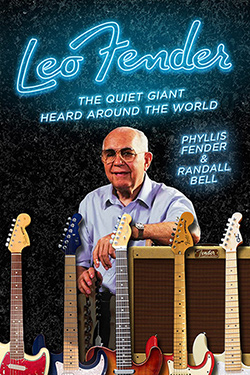 “Occasionally, the world produces one of those rare thinkers that alters the course of history.” The rare thinker in this case is Leo Fender, founder of the Fender Musical Instrument Company, G&L Musical Instruments and past president of Music Man Instrument Company. In her new book, Leo Fender: The Quiet Giant Heard Around the World, Leo’s widow Phyllis Fender presents Leo Fender as a simple, yet extremely creative man…a man arguably responsible for changing the course of human history.
“Occasionally, the world produces one of those rare thinkers that alters the course of history.” The rare thinker in this case is Leo Fender, founder of the Fender Musical Instrument Company, G&L Musical Instruments and past president of Music Man Instrument Company. In her new book, Leo Fender: The Quiet Giant Heard Around the World, Leo’s widow Phyllis Fender presents Leo Fender as a simple, yet extremely creative man…a man arguably responsible for changing the course of human history.
His story is simple and apparently so was he. Phyllis and her co-author Randall Bell present Leo as such a banal man regarding his daily life that to think he could go on to invent a toaster, not to mention the electric guitar, would be a stretch of the imagination. For those looking for details on his creations…look elsewhere. Phyllis writes up front, “This book is less about guitars, but more about the man who invented them.” Unfortunately the man who created such beautiful instruments was quite boring and tales of his eating and dressing habits can be of interest to few, if any.
Leo Fender was born in 1909 and lived his whole life in Fullerton, CA. He attended high school and college in town, and was first married in 1939. After Pearl Harbor, his effort to join the Army was thwarted due to his having lost an eye in a childhood accident. Growing up he loved music but had no musical talent. His personal proclivities lent themselves to electronic tinkering, and Phyllis writes: “Soon after college, Leo, whose skill with electronics had been spreading, was asked by a local band if he would make a public-address system.” He did and became more and more interested in music and what all the various musical components were. “During the 1940s Leo would attend War Bond Dances,” Phyllis writes. “He enjoyed big band music and admired musical talent. While the guitarists played their wooden, acoustic guitars with all their might, nobody could hear them. They were playing their hearts out but were basically invisible! Leo felt bad for them. The guitarists had to be heard! Leo got an idea. He was determined to help these talented musicians be heard, just like the rest of the band.”
From here Leo Fender invented the first solid body electric guitar, the Esquire [this point can be argued…but not here]. This model soon became the Telecaster and is still one of the most popular guitars today. A gem of information found in the book is that the word “telecaster” was a simple blend between the new, upcoming televisions and radio broadcasters.
One major point of issue with Fender Instruments is the regard of their stature before and after Fender sold his company to CBS in 1965. “Pre-CBS” is a seemingly important delineation point for players. According to Phyllis, there is nothing to it. Leo Fender’s “rigorous daily grind eventually got to be too much for Leo and he became sickly and tired,” she writes. “Most people did not know it, but Leo had gotten a severe staph infection. It lingered and lingered and eventually got worse. The doctors told Leo that his was incurable and that he was going to die, so, in 1965 Leo decided to sell the company he had built. He wanted to wrap up his affairs so that when he died his [first wife] Esther would not have to deal with them.” This illuminates the sale as a way for Leo to protect/provide for his family after he was gone. As it turns out…his doctors were wrong and another doctor cured him. He later regretted the sale. Still, “There is a preconception that pre-CBS guitars are better, but that is just plain false,” she goes on to say. Both Fender and an original partner worked at both pre- and post-CBS Fender and neither would have ever tolerated any decline in quality.
The book is a nice history of a time and a place in American ingenuity, but there just does not seem to be much to Leo Fender as a person. We do learn that his favorite musician was Glen Campbell and that “Leo was not happy about Jimi Hendrix smashing Stratocasters.” He was friends with Les Paul, one of his equals over at Gibson, Fender’s main competitor. Fender did lead a nice life…he enjoyed travel and shunned the spotlight whenever possible. He was inducted into the Rock and Roll Hall Of Fame in 1992, the year after his passing. Most of Leo Fender: The Quiet Giant Heard Around the World is about his eating habits (Carl’s Jr. and Sizzler) and his love of girls in tight jeans. A final interesting point is what provoked him to make guitars in the first place. According to a story Leo told Phyllis, he had a deeply personal dream where Jesus had told him that the world was a tough place, that musicians were really angels who were sent to make the world a little better. His contribution in this regard cannot be overstated.

V11 Review: Leo Fender: The Quiet Giant Heard Around the World
Read More ▼
V11 Review: Leo Fender – The Quiet Giant Heard Around the World by Phyllis Fender and Randall Bell

Expectations can be a dangerous thing. I expected a book about Leo Fender to be about his guitars and his encounters with musicians. Do not expect this from this book. But when you read about Leo Fender you also learn that his life was not focused on encounters with musicians and other exciting yarns with celebrities. This book is written by his second wife Phyllis Fender along with Randall Bell, whose father led the R & D team there for many years. This is more of a story of his life as told in a loving way by Phyllis.
8 Facts about Leo FenderSo, once I got past my disappointment about not reading about exciting musician meetings, or if there were they were very brief like the one about Prince that the encounter lasted about as long as it took you to read this sentence. I enjoyed the book. I always find it interesting to read about true genius and Leo Fender fit this category, so if you want to read a book about a man who revolutionized the music industry I would recommend this book. This is a quick read that will give you a peek inside the life of a man who overcame health problems and learned that dedication to a career that you love is time well spent.
Leo you were a man who could not play a guitar, but my ears thank you for years of great music.
Just Dug

Leo Fender, Ace Frehley and the Guitar That Got Away
Read More ▼
V11 Review: Leo Fender – The Quiet Giant Heard Around the World by Phyllis Fender and Randall Bell
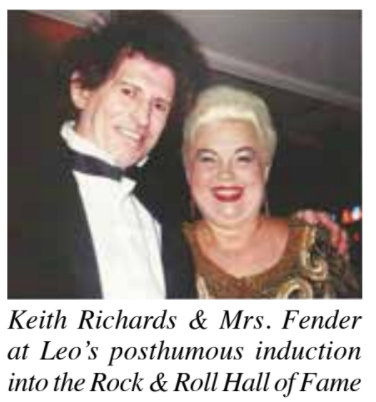
While much has been written about the work of Clarence Leonidas “Leo” Fender, precious little has been written about Leo Fender the man. In the recently-released Leo Fender: The Quiet Giant Heard Around The World by the person who knew him best – his wife Phyllis — co-authored with Dr. Randall Bell (who grew up in Fender’s neighborhood and whose father was the head of the R & D department at Fender’s company), we get to know the quiet and not- so-quiet sides of the aforementioned quite giant. The book is Leo’s love story and Phyllis tells it charmingly and lovingly.
My favorite part is Phyllis telling us “Leo was not a particularly religious person but he felt that musicians were angels, sent down to make the world a better place and it was his job to help facilitate their work.”
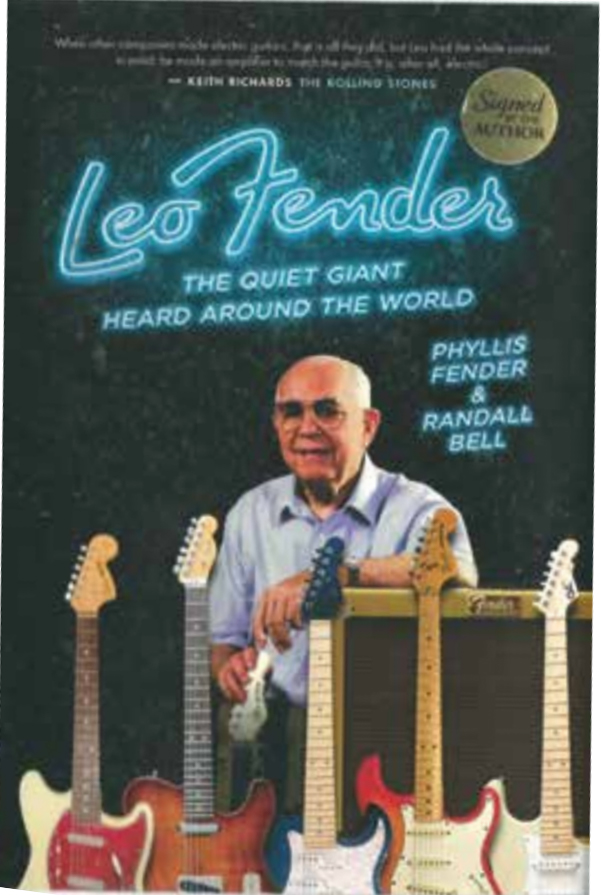 I can imagine there aren’t as many stars in the sky as there are notes glissandoed, plucked, hammered and bent from the plethora of guitars that bear the Fender name, not to forget revolutionary amplifiers and sought after Fender Rhodes pianos as well. Every famous musician has a Fender story and I have mine, how (for better or worse) I was an integral part in the formation of KISS. Here’s the story of that ‘63 Telecaster — the guitar that got away. Must have been December because it was getting near Christmas, 1965, ˆwas fourteen, gonna be 15 Dec. 28th, sitting in what they used to call Hygiene or Health Ed., a classroom requirement usually taught be a gym teacher. This particular teacher was yukking it up with us comparing Santa Claus to the Sanity Claus and I looked over to my left and the guy next to me had a page full of guitars all drawn. I said to him do you just draw them or do you play? He said he plays and I said we could get together and rehearse. I had good equipment: a Farfisa Combo Compact organ and an Ampeg B-12 amp. A mutual friend, Mark Peritz, was our drummer and I found myself in Mark’s apartment with Paul Frehley on the guitar. Paul had a very unusual instrument: a teardrop Fender Telecaster, which he cut down himself, down to the pick guard and it looked almost as cool as he made it sound. Even then, he had the licks, starting with the Blues Magoos “Nothin’ Yet” up to the Animals “Don’t Let Me Be Misunderstood.”
I can imagine there aren’t as many stars in the sky as there are notes glissandoed, plucked, hammered and bent from the plethora of guitars that bear the Fender name, not to forget revolutionary amplifiers and sought after Fender Rhodes pianos as well. Every famous musician has a Fender story and I have mine, how (for better or worse) I was an integral part in the formation of KISS. Here’s the story of that ‘63 Telecaster — the guitar that got away. Must have been December because it was getting near Christmas, 1965, ˆwas fourteen, gonna be 15 Dec. 28th, sitting in what they used to call Hygiene or Health Ed., a classroom requirement usually taught be a gym teacher. This particular teacher was yukking it up with us comparing Santa Claus to the Sanity Claus and I looked over to my left and the guy next to me had a page full of guitars all drawn. I said to him do you just draw them or do you play? He said he plays and I said we could get together and rehearse. I had good equipment: a Farfisa Combo Compact organ and an Ampeg B-12 amp. A mutual friend, Mark Peritz, was our drummer and I found myself in Mark’s apartment with Paul Frehley on the guitar. Paul had a very unusual instrument: a teardrop Fender Telecaster, which he cut down himself, down to the pick guard and it looked almost as cool as he made it sound. Even then, he had the licks, starting with the Blues Magoos “Nothin’ Yet” up to the Animals “Don’t Let Me Be Misunderstood.”
 My organ playing, I can say, was a work-in-progress and summer came and we went our separate ways. I spent most of my high school time working on the school and local paper, playing night center basketball and managing the handball team. That hundred dollars I paid the Ace for the Axe was immediately converted into the Les Paul he used to audition for Simmons and Stanley who were converting their band “Wicked Lester” into the aforementioned cultural phenomenon. I would run into Ace kind of regularly as he would hang out with his brother who attended Bronx Community College when it was on Grand Avenue and 183rd Street. Ace would be on chick patrol, wearing a pinstriped sport jacked with a Superman button, and those now famous red and yellow Converse All Stars even as he was driving a cab and auditioning for Three Dog Night. The last time I saw him before he made it big, we sat on a stoop on the Grand Concourse and he took my acoustic guitar and ran through most of “Tommy.”
My organ playing, I can say, was a work-in-progress and summer came and we went our separate ways. I spent most of my high school time working on the school and local paper, playing night center basketball and managing the handball team. That hundred dollars I paid the Ace for the Axe was immediately converted into the Les Paul he used to audition for Simmons and Stanley who were converting their band “Wicked Lester” into the aforementioned cultural phenomenon. I would run into Ace kind of regularly as he would hang out with his brother who attended Bronx Community College when it was on Grand Avenue and 183rd Street. Ace would be on chick patrol, wearing a pinstriped sport jacked with a Superman button, and those now famous red and yellow Converse All Stars even as he was driving a cab and auditioning for Three Dog Night. The last time I saw him before he made it big, we sat on a stoop on the Grand Concourse and he took my acoustic guitar and ran through most of “Tommy.”
 As for that sweet Telecaster, let’s just say it met an unfortunate ending at the Music Inn on Bleecker Street, too sad to recount here. I still have Matt Umanov’s appraisal as proof and the memory of rockin’ out with my band playing Elvis and Carl Perkins tunes in Fred’s studio/apartment on Belmont Avenue. Today, it is in the process of being recreated in acrylic by Mitch Meisner at Meisner Acrylic Casting in Deer Park, NY.
As for that sweet Telecaster, let’s just say it met an unfortunate ending at the Music Inn on Bleecker Street, too sad to recount here. I still have Matt Umanov’s appraisal as proof and the memory of rockin’ out with my band playing Elvis and Carl Perkins tunes in Fred’s studio/apartment on Belmont Avenue. Today, it is in the process of being recreated in acrylic by Mitch Meisner at Meisner Acrylic Casting in Deer Park, NY.
“If Leo had stopped after creating the Telecaster he would still hold a secure place in guitar history.” Eric Dahl, Maverick Magazine. I certainly agree with that.
 Back to the matter at hand: “The world occasionally produces one of those rare thinkers whose name becomes iconic. Thomas Edison lit up the world; Albert Einstein profoundly altered the study of physics; Walt Disney re- imagined entertainment; and Leo Fender invented the electric guitar. He grew up in Fullerton, California, where his interest in electronics lead him to open his own radio repair shop in 1938. It wasn’t long before musicians and band leaders turned to him for help in repairing their equipment...and the rest, as they say, is history. While his name is synonymous with fist-pumping rock and roll sound, in reality, Fender was a shy, unassuming inventor who was nearly deaf and had one glass eye. In 1946 he founded Fender Electric Instrument Manufacturing Company — the launch pad for his most iconic designs — and later on, G&L Musical Instruments. Today, Fender is a household name. But the quirky, shy inventor never lived large or flaunted his fame. He lived in a mobile home, even after selling his company for $300 million (in today’s dollars). His daily routines and obsessions made him truly fascinating, and thanks to his enduring instruments, Fender’s legacy forever lives on.” — VICTOR FORBES
Back to the matter at hand: “The world occasionally produces one of those rare thinkers whose name becomes iconic. Thomas Edison lit up the world; Albert Einstein profoundly altered the study of physics; Walt Disney re- imagined entertainment; and Leo Fender invented the electric guitar. He grew up in Fullerton, California, where his interest in electronics lead him to open his own radio repair shop in 1938. It wasn’t long before musicians and band leaders turned to him for help in repairing their equipment...and the rest, as they say, is history. While his name is synonymous with fist-pumping rock and roll sound, in reality, Fender was a shy, unassuming inventor who was nearly deaf and had one glass eye. In 1946 he founded Fender Electric Instrument Manufacturing Company — the launch pad for his most iconic designs — and later on, G&L Musical Instruments. Today, Fender is a household name. But the quirky, shy inventor never lived large or flaunted his fame. He lived in a mobile home, even after selling his company for $300 million (in today’s dollars). His daily routines and obsessions made him truly fascinating, and thanks to his enduring instruments, Fender’s legacy forever lives on.” — VICTOR FORBES

